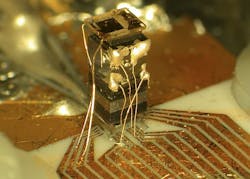Four research companies to design battery-powered atomic clocks for use in GPS-denied environments
ARLINGTON, Va., 13 Sept. 2016. U.S. military researchers are asking four companies to create new technologies leading to small, lightweight, and power-efficient atomic clocks suitable for battery-powered portable applications in GPS-denied environments.
Officials of the U.S. Defense Advanced Research Projects Agency (DARPA) in Arlington, Va., have awarded four contracts for initial phases of the Atomic Clock with Enhanced Stability (ACES) program.
ACES seeks to provide unprecedented frequency and timing accuracy on low size, weight, and power consumption (SWaP) platforms. These battery-powered atomic clocks should require minimal time for calibration after power-on, and maintain accurate time and frequency over extended duration suitable for military applications.
The four companies chosen for the DARPA ACES program are Physical Sciences Inc. in Andover, Mass.; OEwaves Inc. in Pasadena, Calif.; HRL Laboratories LLC in Malibu, Calif.; and the Charles Stark Draper Laboratory Inc. in Cambridge, Mass.
Related: GPS jamming is a growing threat to satellite navigation, positioning, and precision timing
In August HRL Laboratories won a $775,159 contract for the first phase of the ACES program, with a potential $697,826 option for phase two, while OEwaves won a $1.7 million ACES contract for phase one, with a $1.1 million option for phase two, and a $1.7 million option for phase three.
In September Physical Sciences won a $243,914 contract for ACES phase one, while Draper Lab won a $2.8 million contract for ACES phase one, with a $2.7 million option for phase two, and a $2.2 million option for phase three.
These four companies will try to find ways to overcome technological deficiencies with existing battery-powered timing sources -- namely power-on to power-on frequency changes (retrace) and long-term frequency drift and frequency sensitivity to temperature (tempco).
Today the best battery-powered clocks, developed under the DARPA Chip-Scale Atomic Clock (CSAC) program, provide 100 times superior performance to mechanical oscillators of comparable size, weight, and power consumption.
Related: DARPA eyes inertial navigation technology for GPS-denied environments
Still, they require six to twelve hours of calibration after turn-on, due to retrace error, and support mission durations limited to three to six hours, due to tempco and drift. With the proliferation of chip-scale atomic clocks, DARPA researchers expect even greater opportunities in the future for advanced capabilities enabled by a battery-powered atomic clock with enhanced stability.
In this project, DARPA researchers particularly are interested in clocks with significantly reduced temperature coefficient of frequency, long-term frequency variation (drift), and frequency repeatability under power cycling.
Among their many potential advantages, better clocks could reduce one of the more worrisome modern-day national security vulnerabilities: a deep and growing dependence on the Global Positioning System (GPS), not just within the military but among numerous civilian sectors of the economy, DARPA officials say.
Most precise-timing applications rely on GPS because satellite-based atomic clocks. Increasing threats of GPS jamming may make this source of timing unreliable. The longer that clocks on Earth or on aircraft can maintain extreme accuracy in the absence of satellite reference signals, the lower the impact of any loss of satellite contact, whether caused by natural forces or adversarial activities.
Related: Army asks industry for new kinds of unmanned systems sensing in GPS-denied environments
Physical Sciences, OEwaves, HRL Laboratories, and Draper Lab will focus on two technology areas for the ACES program -- developing an integrated ACES prototype atomic clock; and fundamental research into alternative atomic clock architectures, component technologies, and interrogation methodologies. The companies also will concentrate on technologies that are too risky or immature to include in prototyping an atomic clock.
Precision timing and synchronization is essential to U.S. military communications, navigation, reconnaissance, and other electronic systems, DARPA researchers say.
The requirements for timing precision and stability, moreover, have grown increasingly demanding as systems have evolved towards higher data rates, increased spectrum congestion, and time-dependent encryption algorithms. This demand will continue to grow over the next decade, particularly due to emerging requirements for precision timing in GPS-denied environments and synchronization between system-of-systems components on distributed platforms.
For more information contact DARPA online at www.darpa.mil.
Learn more: search the Aerospace & Defense Buyer's Guide for companies, new products, press releases, and videos

